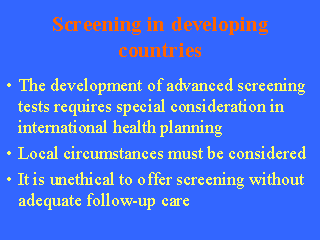|
|
|
|
front |1 |2 |3 |4 |5 |6 |7 |8 |9 |10 |11 |12 |13 |14 |15 |16 |17 |18 |19 |20 |21 |22 |23 |24 |25 |review |
 |
Data on screening tests need to be adapted to local circumstances.
How the test is done may differ. For example, a mammogramís quality
may be different depending on the type of machine that is used.
The radiologistís interpretation may differ depending on experience.
Cultural attitudes towards screening tests may differ across societies.
The availability of resources for follow-up and treatment may differ
drastically across countries. Thus, quite different approaches to screening may be necessary. For example, visual inspection of the cervix, or cervicography (a photograph of the cervix) may be alternatives to the Pap smear in many countries. Similarly, clinical examination of the breast, either by a physician, or another health professional, may be an alternative to mammography. Ethical considerations are especially important when considering applying screening tests in developing countries. While some may argue that is unethical not to offer tests that are available in other countries, it is less ethical to offer tests for which adequate follow-up is not available, or to offer tests that draw resources away from activities that might better improve the health of the population, such as prenatal care or immunization programs. |
|
|
|
|
front |1 |2 |3 |4 |5 |6 |7 |8 |9 |10 |11 |12 |13 |14 |15 |16 |17 |18 |19 |20 |21 |22 |23 |24 |25 |review |